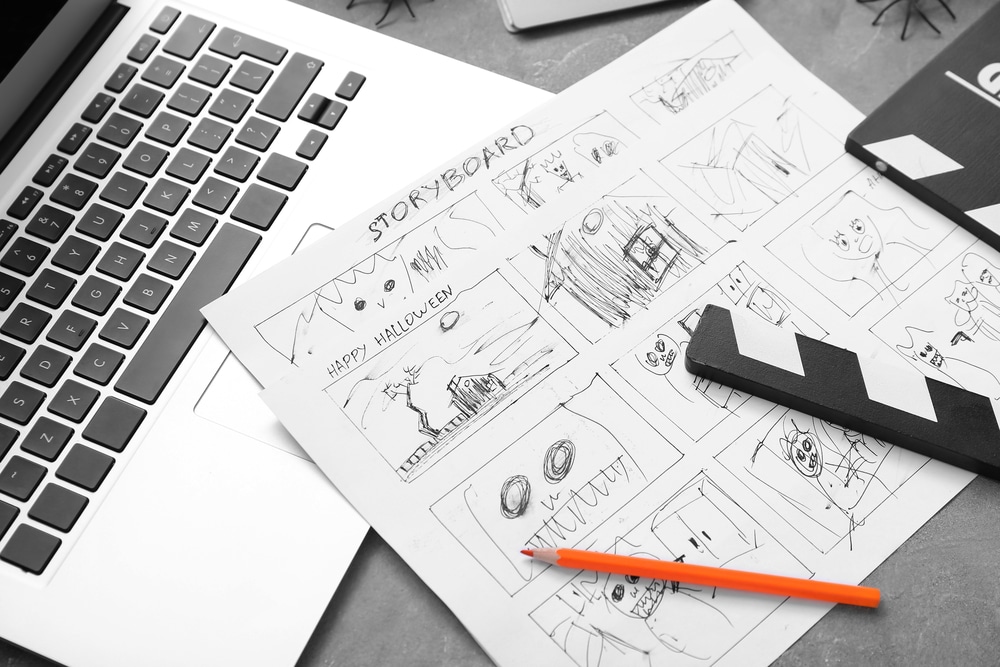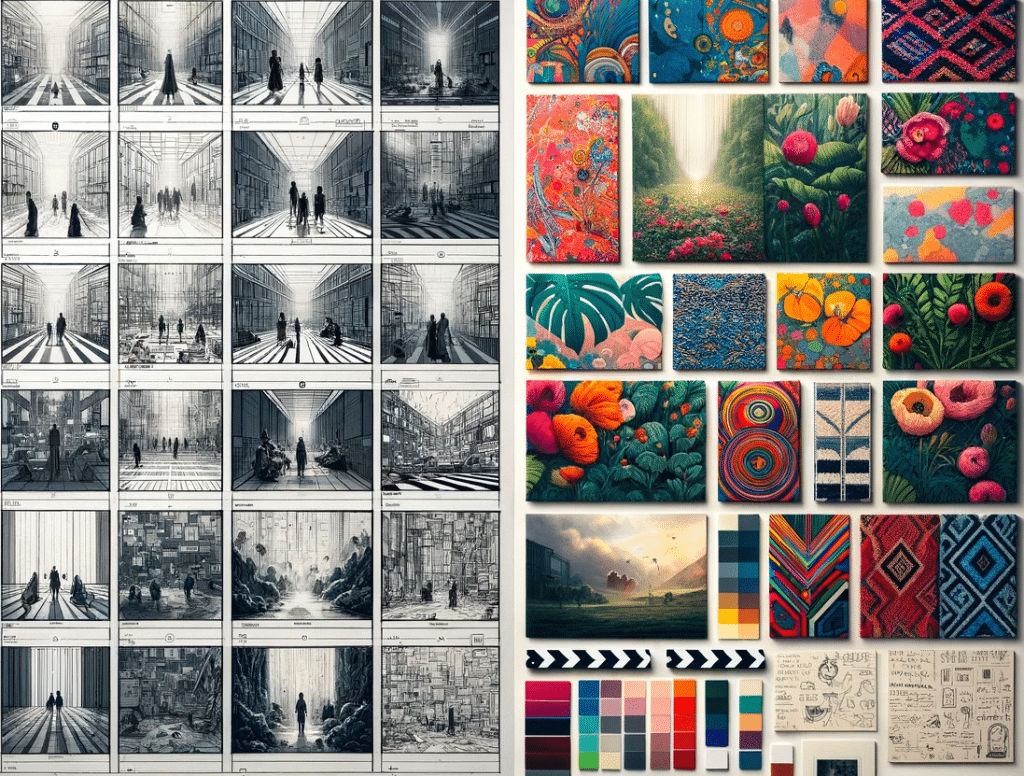Heard about storyboards and moodboards? It can get quite confusing at times. But in this article, we’ll figure out the difference between the two and explore which is best suited for different types of projects.
What is a Storyboard?

A storyboard is like a comic strip that helps tell a story before it becomes a movie, animation, or any visual project. Imagine a series of pictures, each showing a different scene or moment in the story. These pictures are organized in a sequence to outline how the story unfolds.
Why is it Important?
- Planning: It’s a roadmap for creators. Just like a map helps you navigate, a storyboard guides the team through the story, making sure everyone is on the same page.
- Visualizing: Each frame in the storyboard shows a specific part of the story, helping directors, animators, and the whole team see how the scenes will look.
- Communication: It’s like a universal language for the creative team. Instead of just talking about the story, they can look at the pictures and understand exactly what the director envisions.
How is it Made?
Traditionally, it’s drawn on paper with sketches and notes. Nowadays, digital tools are also used, making it easier to edit and share with the team.
Tip: There are AI storyboard generators available you can use to streamline the storyboarding process. With just a few clicks, you can create and generate multiple storyboards without the need to start from scratch.
A storyboard is a visual plan that brings a story to life. It’s the creative team’s guide to make sure everyone works together to tell a great story, whether it’s on the big screen or a smaller project.
What is a Moodboard?

A moodboard is like a visual collage that sets the vibe and style for creative projects. Think of it as a collection of pictures, colors, and textures carefully put together to create a certain mood or atmosphere.
Why is it Important?
- Setting the Tone: It’s an emotional compass for projects. Whether it’s graphic design, interior decorating, or branding, a moodboard helps establish the overall feel.
- Conveying Ideas: Instead of describing how a project should look, a moodboard shows it. It’s a way for creators to share their vision with the team and make sure everyone is on the same creative page.
- Inspiration: By combining different visuals, a moodboard sparks ideas. It’s a source of inspiration that helps the team understand the project’s aesthetic direction.
How is it Made?
Traditionally, people cut out images from magazines and put them on a physical board. Nowadays, it’s often done digitally using tools like Canva, Milanote, and many more.
A moodboard is a creative mix of visuals that captures the feeling a project should evoke. It’s the team’s guide to creating a consistent and appealing look, ensuring everyone works together to bring a unique vibe to the project.
Purpose and Functionality of Storyboard and Moodboard
Storyboard’s Role in Narrative Precision:
- Acts as a detailed guide for storytelling in films, animations, and marketing campaigns.
- Frames each moment, helping the creative team see the story’s progression.
- Functions like an architectural blueprint, detailing events, camera angles, and character positions.
- Ensures the final product matches the director’s vision by providing a visual representation.
Moodboard’s Emphasis on Atmosphere and Emotion:
- Immerses in the intangible aspects like emotions and aesthetics of a project.
- Serves as an emotional compass, guiding the project towards a specific ambiance.
- Transcends linear narratives to focus on overall feelings to be conveyed.
- Captures the essence of a brand or scene through color palettes, imagery styles, and emotional connotations.
- Thrives on creative fluidity, encouraging exploration and interpretation by collaborators.
- Sets a collective vision for the project’s overall aesthetic without strictly defining shots or sequences.
Applications in Various Projects
Storyboard:
- Film and Video Production: Use to plan and visualize scenes, camera angles, and the overall flow of the narrative.
- Animation: Essential for plotting the sequence of animated frames and ensuring smooth storytelling.
- Marketing Campaigns: Helps in crafting visual narratives for advertisements, ensuring a cohesive and engaging storyline.
- Interactive Media Development: Guides the progression of events in video games, virtual reality experiences, and interactive applications.
- Educational Content Creation: Useful for designing instructional videos, e-learning modules, and educational animations.
Moodboard:
- Graphic Design: Sets the visual tone for branding, providing a reference for color palettes, imagery, and overall aesthetic.
- Interior Design: Communicates the desired mood and atmosphere for a space through color schemes, textures, and design elements.
- Fashion Design: Helps convey the style, color palette, and overall vibe of a clothing line or fashion collection.
- Brand Development: Establishes the emotional identity of a brand through visuals, helping to create a consistent and appealing image.
- Event Planning: Guides the overall aesthetic and mood of an event, ensuring a cohesive theme across decorations, invitations, and visuals.
- Content Creation for Social Media: Ensures a consistent and visually appealing style for social media posts, aligning with the brand or content creator’s vision.
Creation Process: Storyboard vs Moodboard
Storyboard Creation
Creating a storyboard involves a systematic approach to translating a script or concept into a visual narrative. Here’s a simplified breakdown of the process:
- Script/Conceptualization: Begin with a solid script or conceptualization of the project. This serves as the foundation for your storyboard.
- Division into Scenes: Break down the script into individual scenes. Each scene will be represented by a series of frames in the storyboard.
- Frame Layout: Decide on the layout for each frame. Consider factors such as camera angles, character positions, and key visual elements. This layout will guide the composition of each shot.
- Sketching: Start sketching the frames. These sketches don’t need to be elaborate; stick figures and basic shapes often suffice. Focus on conveying the essential elements of each shot.
- Annotations: Accompany each frame with annotations. Describe the action, camera movements, and any other pertinent information. This ensures that everyone involved understands the intended visual narrative.
- Review and Iteration: Review the initial storyboard with the creative team. Gather feedback and make necessary adjustments. Iterative refinement is key to achieving a cohesive vision.
Moodboard Creation
Crafting a moodboard involves a more exploratory and subjective process, aiming to capture the essence and mood of a project. Here’s a step-by-step guide to creating an effective moodboard:
- Define the Purpose: Clearly define the purpose of the moodboard. Are you aiming to convey a brand identity, the visual tone of a film, or the overall aesthetic of a design project?
- Gather Inspirations: Collect a diverse range of visual inspirations. This can include images, textures, color swatches, typography samples, and even snippets of text that evoke the desired mood.
- Curate and Arrange: Curate the collected elements into a cohesive composition. Consider the visual flow and how each element contributes to the overall mood.
- Consider Color Palette: Pay special attention to the color palette. Colors evoke emotions, and selecting a harmonious palette reinforces the intended mood.
- Digital or Physical Creation: Depending on your preference, create your moodboard digitally using tools like Canva or physically by arranging printed or cut-out elements on a board.
- Present and Discuss: Share the moodboard with the creative team for feedback and discussion. This collaborative step ensures alignment and allows for adjustments based on collective insights.
Tools for Creating Storyboard and Moodboard
Tools for Storyboarding
Traditional: sketchbooks, notepads, pencils, and markers.
Pros: Tangible, easy to sketch, fosters hands-on creativity.
Cons: Limited editing flexibility, not easily shareable digitally.
Digital Storyboarding Tools: storyboarding software, online storyboard maker, and AI storyboard generators.
Pros: Greater flexibility, efficient collaboration, digital sharing capabilities.
Cons: Learning curve for new software, potential loss of the tactile feel of traditional methods.
Tools for Moodboarding
Traditional Moodboarding (Physical Collage): magazines, scissors, glue, poster boards.
Pros: Tangible and hands-on, offering a tactile experience.
Cons: Limited editing options, less flexibility, and challenging sharing.
Digital Moodboarding Tools: online design platforms, digital whiteboard platforms, and visual collaboration tools such as Canva, Miro, etc.
Pros: Enhanced flexibility with digital tools, easy collaboration, and sharing capabilities.
Cons: Initial learning curve, potential loss of the tangible, hands-on feel of traditional methods.
Key Takeaways:
- Storyboards act as visual roadmaps, guiding the narrative precision in films, animations, and marketing campaigns.
- Moodboards emphasize atmosphere and emotion, serving as emotional compasses for projects.
- Choosing between traditional and digital tools depends on project needs and collaboration preferences.
Frequently Asked Questions (FAQs):
Are storyboards only used in filmmaking?
While storyboards are prominently used in filmmaking to plan and visualize scenes, they extend their influence across various creative fields. Animation, advertising, video game development, and even marketing campaigns benefit from the structured approach of storyboarding.
How often do directors use moodboards?
Directors use moodboards strategically to convey the emotional and aesthetic tone of a project. The frequency depends on the project’s nature; for instance, a brand identity project might heavily rely on moodboards, while a straightforward film narrative may use them more sparingly.
Can moodboards and storyboards be used together?
Absolutely. Directors often find synergy in using both moodboards and storyboards. While storyboards offer a detailed visual narrative, moodboards provide a broader context for the emotional and aesthetic elements, creating a harmonious blend in the creative process.
Do all directors use digital storyboarding tools?
Not necessarily. The preference for digital or traditional storyboarding tools varies among directors. Some appreciate the tactile experience of pen and paper, while others embrace the efficiency and collaborative aspects of digital platforms. Many directors opt for a hybrid approach, combining both methods as needed.
How can AI assist in storyboarding?
AI can play a role in automating certain aspects of storyboarding, such as scene composition or generating suggestions based on directorial preferences. It has the potential to streamline the initial stages of storyboarding, allowing directors to focus more on refining creative elements.
Are moodboards only relevant in visual arts like design and branding?
While moodboards find extensive use in design and branding, their influence extends across various creative domains. In film production, for example, a moodboard can encapsulate the overall emotional tone of a scene or the visual aesthetic of an entire film.

